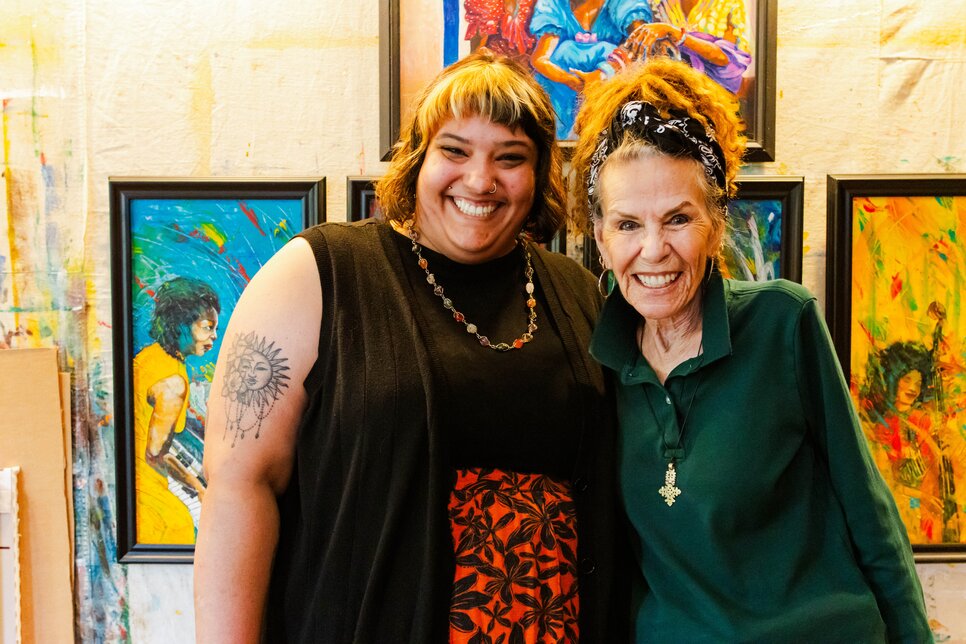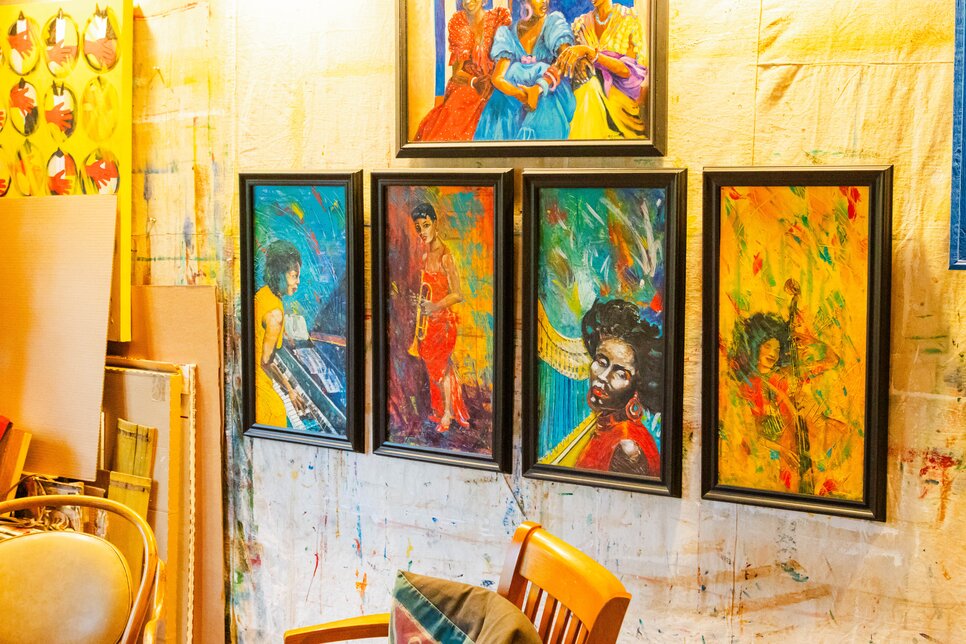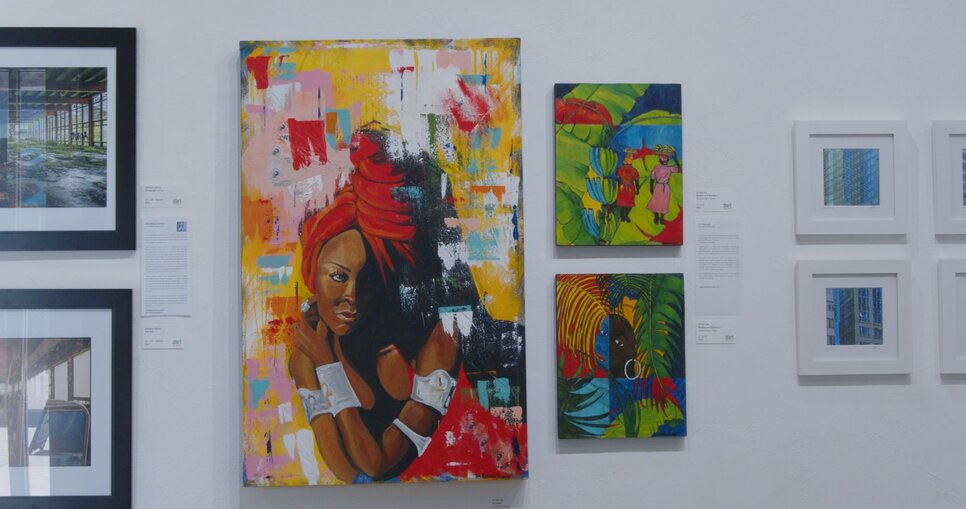Inside the Art & Soul of SA Bennett | Afro-Caribbean Stories, Jazz Icons & a Life in Color

SA Bennett is an artist in our community portraying the African Diaspora through art. She taught young and aspiring artists for over 30 years here in Denver, through Denver Public Schools, as well as in Jamaica. Now, she's busy enjoying a well-earned retirement, returning full time to her 1st love of painting. With her brush in hand, she stays inspired, challenging herself to explore new styles & techniques "I have been changing my style a little bit. I'm a representational artist, but I like to experiment. So I've been going a little bit more abstract, as you can tell by the backgrounds. But I feel that art should have a human touch to it or something that is relatable as life, an animal or person. So I like to combine representational with abstract and that's the path I'm on right now." Her art is currently being displayed at the D'Art Gallery as part of a larger collection called "Impressions." Now through June 29, her colorful paintings titled "Reynalda" (Acrylic on Canvas) and 2 of the paintings in her collection titled "Rhythm and Shadow" (Wood & Mylar Panel) hang at the gallery. Their opening reception is happening June 13 from 6-9 p.m.
I visited SA Bennett's home studio in anticipation of this art show and was met with an afternoon of wisdom, laughter, and vibrant color. The walls were lined with her oil paintings, all celebrating the Afro and Afro Caribbean life. Through expressive brush strokes, she honors the stories of her friends and family and the spirit of those she knew that have since joined the ancestors. She also captures the essence of artists, musicians, authors, and other creatives that have impacted her, "I think that the common thread, no matter what I'm doing, drawing, or any type of painting or construction, is the African Diaspora, because I'm very interested in what happened after slavery. We've picked up influences, we've contributed to cultures, and we are still thriving and changing and growing, and I like to call attention to that fact through art." Four portraits of four iconic women in jazz hung behind us as we spoke.
Transcript
ABI: Thank you so much for having me in your home studio. I'm with you, SA Bennett, among all of your artwork. Thanks so much for having me here.
SA BENNETT: Well, thank you so much. It's wonderful to be with you again, Abi.
ABI: Yes.
SA BENNETT: And I appreciate the opportunity to share my art.
ABI: We're among some of the first artwork that was the reason why I was able to meet you. We were introduced by a mutual friend for your "Women in Jazz" paintings, but you have your entire home studio filled with paintings. I would love to learn: are these a collection throughout your life or some more recent paintings or?
SA BENNETT: I would say the majority are in the last five years or newer. I have been changing my style a little bit. I'm a representational artist, but I like to experiment. So I've been going a little bit more abstract, as you can tell by the backgrounds. But I feel that art should have a human touch to it or something that is relatable as life, an animal or person. So I like to combine representational with abstract and that's the path I'm on right now.
ABI: It's so emotional because of that. And you've been painting your whole life, right?
SA BENNETT: Oh yes.
ABI: Do you remember when you first picked up the paintbrush or the pencil to start your artwork journey?
SA BENNETT: Yes. I was just a really little kid and I had a crayon and I drew on my sheets and I didn't just draw a person. I drew the entire village with a road and people alongside, and I got into big trouble with my mother for that.
ABI: But still creating nonetheless. And art was something you knew you wanted to do with your life?
SA BENNETT: Always. Always.
ABI: Yeah. And that's what brought you to Denver, was doing artwork?
SA BENNETT: Yes. I was introduced to Mel Strawn (Director) at Denver University('s School of Art). I had a letter and I got in having shown him some of my work and I was accepted at DU through the foreign studies. Yeah. And I, from there, spent over 20 years with Denver Public Schools teaching art.
ABI: And you taught, I think from talking with you, in a couple different countries, too.
SA BENNETT: Oh yes. I taught in Jamaica and I taught here and I taught in Texas, in Port Arthur, Texas.
ABI: Always paint.
SA BENNETT: Always. Yes, and high school and middle school. And I love my students. I do miss my students, but it's wonderful to have the time now in retirement to be a full-time artist.

ABI: And so like you said, you've been experimenting, which I'm sure as an artist, you've kind of tried different things throughout your work, but there's been kind of a constant theme with your collections of work, right? Around the Afro and Afro-Caribbean life?
SA BENNETT: Absolutely, yes. I think that the common thread, no matter what I'm doing, drawing, or any type of painting or construction, is the African Diaspora, because I'm very interested in what happened after slavery. I feel like slavery gets too much attention, as horrifying as it was. There was a millennia before slavery, and there's been 140 million years after that we as a people have changed and grown. We've picked up influences, we've contributed to cultures, and we are still thriving and changing and growing, and I like to call attention to that fact through art.
ABI: You do it so well in these character portraits, the "Women in Jazz". I know we don't hear a ton about women in jazz, at least historically.
SA BENNETT: That's right.
ABI: But here you've taken four dynamic women through history and depicted them in this style. Can you talk about the journey of depicting a person, what kind of steps do you go through?
SA BENNETT: Well, for these, I was so incensed to realize that these are very powerful women and they made huge contributions to jazz and nobody knows who they are. So the idea for this series of "Women in Jazz" is to call attention to those women who were in the background, but whose influence we feel all the time in our current jazz movements. Mary Lou Williams was, she started out in the blues. She became a musical arranger, fabulous musician. Of course. Alice Coltrane. I did her husband too, but I named that painting "Alice's Husband".
ABI: I love these paintings. And I've seen you've done Celia Cruz and some other Cuban style works like these women up here.
SA BENNETT: Yes.
ABI: So you're diving into these different cultures that are part of the African diaspora?
SA BENNETT: Absolutely. For Celia Cruz, she was the most dynamic woman, and she has sort of a sister in Miriam Makeba, who both of them were exiled from their countries. Both of them were refused to be allowed home when their mothers got ill and they lost their mothers and never got to see them. And yet, they're the most dynamic women. So yes, Celia Cruz is Cubana, and these ladies are too. And I love these ladies because they're such a combination of culture. Obviously they've got Spanish clothing articles, but the head wraps are African, and I think it's so difficult to really, really categorize people when we overlap so much. And the truth is we are all so connected.
ABI: Is that one of the biggest takeaways from doing the work that you do?
SA BENNETT: Absolutely. It's been a great education for me to really explore the diaspora and see what we have accomplished, what has really happened. And it's amazing. It's an amazing journey.

ABI: I want to draw attention to your use of color because a lot of your paintings are so vibrant. And in a moment we're going to speak about work that's currently up right now in Denver for viewing, but does the color, does your time teaching in Jamaica influence some of the choices, the vibrancy and the paint, or does it depict change per painting or per person?
SA BENNETT: Absolutely. I think that in Jamaica, the colors are so brilliant, just amazing. And while I was just having a conversation with a friend of mine who's from South Africa, and she said, your greens, how many rays of green are there? And there's countless. So Jamaica and the Caribbean and some of my travels have fed my color sense. I love the vibrancy of color. I think color has an emotional resonance. When you see it, you respond. And it is mood lifting and exciting to see visually.
ABI: And it draws you in, especially the backgrounds that you've been doing now. They're so explosive and dynamic. They capture so much emotion.
SA BENNETT: Well, thank you.
ABI: You're welcome. I know that you've depicted so many people in your time painting, and I was struck by a few of the paintings of people that you knew in your life. For instance, there's a painting in your other room of Ms. Betty, someone that you met.
SA BENNETT: Yes, Betty, Ms. Betty was a fantastic lady. She was an artist of the vernacular, and that's the whole title of that piece because I think she deserves the title. Ms. Betty made art out of stuff she found on the ground, pieces of wood, wire, whatever was there. Then she painted faces on them and her yard was full of stuff like that. And so I greatly admire people who do art because it just springs out of them. I took training, a lot of training to get where I am, but people like Ms. Betty's voice is so pure because it's not a trained voice. It's just an emotional voice. And that's why I did Betty, because I love her.
ABI: It's amazing to also capture the essence of people that are no longer with us, like Bob Raglin, who's a staple in this Denver art community. Can you talk about him a little bit and being a part of the art scene yourself, what it's been like over the years here, the community?
SA BENNETT: Well, I miss Bob very much. He passed away a few years ago. There is a library named after Bob, the Bob Raglin Library. He was an artist and he was one of my first art teachers. And he was a big influence, and he was very, very supportive of all the young artists coming up. He wanted them to understand that their work is valuable, that their skills are valuable, that it's worth getting paid if you can do something like that. So he was very influential in the business of art, and he made no bones about it. If you're an artist and you work hard, you should get paid.
ABI: That's the truth.
SA BENNETT: And that's like, well, I've had some art friends say, "oh, but you do it for the emotional gratification." Well, that don't pay the rent.
ABI: You say the same thing about musicians too. Of course, part of it is exposure, but it's so important to hold yourself and your work at that level. So to have mentors that are seeing that in you and cultivating that,
SA BENNETT: Absolutely, you are valuable and your skills are valuable.
ABI: You're an educator yourself, and I'm sure painting and any kind of art, it's like putting a mirror in front of yourself. What would you say is one of the invaluable things that you've learned from having art so close to your heart, your entire life?
SA BENNETT: Again, it's that sense of connection. As I was telling you earlier, it's nice when you spend the majority of your life facing the wall painting, when someone else values what you're doing. That's wonderful. But also, it's been a journey through human nature for me. We are so connected. There are so many things that bind us as human beings together. And especially in times like these where people are focusing on the differences, I think art is one avenue that helps bring people together.
ABI: So your artwork is currently at D'Art in the Santa Fe Art District?
SA BENNETT: Yes.

ABI: Part of a larger collection called "Impressions".
SA BENNETT: Yes.
ABI: It's up through the end of June. And your opening reception is the 13th where you're going to be inviting some folks to come out, everyone to see the work. Can you talk a little bit about that collection?
SA BENNETT: Oh, certainly. The painting, there's a large painting called "Reynalda" that is, again, a representational figure with an abstracted background. I'm really liking what that looked like. And I did four panels. Two of them are in the show called "Rhythm and Shadow", and those really do harken back to Jamaica and Jamaican colors. They're very vibrant and there's a mixture of flora and fauna and representational human figures. So those are in the show.
ABI: I know there's one that's kind of similar in style in the other room. It looks like banana leaves.
SA BENNETT: Yes.
ABI: Yes. Man, my mom's from Puerto Rico, so the Caribbean lifestyle, it is so different. So to be able to bring that here and show people a glimpse of what that's like.
SA BENNETT: That's right. So you're an island girl too?
ABI: Yes, ma'am.
SA BENNETT: Alright, alright!
ABI: Yes. So that collection is up as part of "Impressions" at the D'Art, and it'll be through June through the end of June, June 29th. And there'll be details at the website on that. And in terms of the year, do you have anything that you're working towards or any goals as far as your artwork goes?
SA BENNETT: Well, I'm going to have a show in November of small works that I'm getting ready for because I'm experimenting with transfers, which are images that an artist can manipulate,
ABI: Like a film kind of situation?
SA BENNETT: Yeah. Or you can lift a page off of a magazine and just choose the images that you want.
ABI: Like a collage kind of.
SA BENNETT: Exactly. Exactly. But they're all created on a flat surface. In other words, there's not pieces of the magazine itself glued down. You use an emulsion and you can peel it off and the image stays, and from there on you can play with it. It's really fun.
ABI: That sounds like a blast. You got to always be learning new, new techniques and all of that. It's very similar to life.
SA BENNETT: Yes. Well, I feel like you're the same type of learner. You're a lifelong learner, and that's it. Keeping your mind open no matter how old or how young you are, makes a difference. Makes a difference. It's a level of awareness that not everybody has.
ABI: SA Bennett, thank you so much for inviting me in your home around your paintings and getting to learn a little bit about your journey.
SA BENNETT: Abi, it's been a real pleasure. Thank you so much for this opportunity to share my work.
Stay connected to KUVO’s programs and our community! Sign up for the Oasis E-News today!


